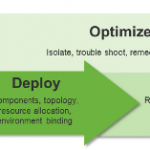Virtualization products comparisons are almost common, but usually are too much (single) vendor oriented and each try to bring better conclusion on its products. So it’s difficult find something that it’s really independent. Also customer experiences could be polarized by their knowledge and the experience itself, or (and this could be worst) by a better design or architecture choice.
I’ve write something one year ago (see this post), but of course products change so things also change. So part is still valid and part must be updated.
Some of the recent tasks in CloudCred (here le complete list) are related on the comparison between VMware vSphere and Microsoft Hyper-V (the first two enterprise virtualization products), of course mainly with the VMware’s point of view (but not in all task).
There are a lot of documents and link that could be interesting:
- Differences between Microsoft’s Hyper-V 3 and VMware’s vSphere 5.1
Main message is that VMware is a “real” Hypervisor (OS independend), has several security and business continuity functions, and is wide used in the enterprise with a broad support - vSphere with Operations Management—Raising the Bar for Integrated Cloud Management
Focused on the Operation and Management part - White paper on the high costs of using Hyper-V over vSphere
Consideration about the cross-platform management and how managing VMware vSphere using Microsoft System Center increases costs and complexity - Blog post: “Flawed Logic Behind Microsoft’s Virtualization and Private Cloud Cost Comparisons”
Response on the Microsoft’s blog article claiming that VMware’s Cost-Per-Application Calculator admits VMware’s costs are higher. Possible mistake in the blog:
1. The incremental cost of Microsoft Premier Support needs to be added to Microsoft’s total cost.
2. The claim that Dynamic Memory improvements in Hyper-V 2012 will reduce the 20% VM density advantage VMware calculator assumes is unsupported.
3. vFabric APM and Service Manager costs need to be excluded for VMware.
4. The additional costs a customer has to incur with 3rd party solutions given the lack of various critical features in the Microsoft stack needed to be added. - Paper “Total Cost Comparison: VMware vSphere vs. Microsoft Hyper-V”
- Paper “Virtualization Performance: VMware vSphere vs Microsoft Hyper-V”
(old comparison with Hyper-V2 SP1) - How VMware vSphere Hypervisor is more reliable than Microsoft Hyper-V
- Review: “VMware vSphere 5.1 looms large”
Focus on the benefit of vSphere 5.1 - Get the Facts: Learn the truth about the difference between VMware vSphere and Microsoft Hyper-V
- Learn how to manage vSphere 5.1
- “Hyper-V and VMware vSphere Architectures: Pros and Cons”
- “The Top Four Hyper-V Virtualization Problems that Plague Admins”
1. Backup stability and support
2. Disk storage: The performance-vs.-disk-space dilemma
3. VM mobility licensing restrictions
4. Memory utilization and memory overcommit - Paper “Hyper-V vs. vSphere: Understanding the differences”
- Paper “VMware vSphere Vs. Microsoft Hyper-V: A Technical Analysis”
- Blog “Five Reasons Why VMware Virtualization is Better than Microsoft Hyper-V”
1. Hyper-V is marketed as free but really isn’t.
2. Hyper-V is not actually bare metal.
3. MS target market is low margin with little to gain because SMBs aren’t ready.
4. Hyper-V ties the hypervisor back to the OS.
5. Virtual Machine Density is a fraction of what is possible - Advantages of vSphere over all other hypervisor systems
One other limit of those references is that, in several cases, the comparison is between old version of the products, in one there were VMware vSphere 4 and Microsoft Hyper-V R2 (as part of Windows Server 2008 R2)… This are changed a lot, so some of the considerations are outdated.
There are also some funny video, available on Vimeo:
“Virtualize Everything” (video link)
VMware’s “Maximum Uptime” (video link)
VMware’s “Total Cost of Ownership” (video link)
VMware’s “Built for the Future” (video link)












